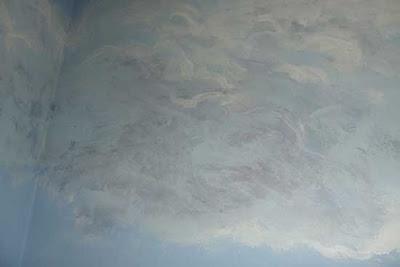I have been asked to paint a cloudy sky in an office open meeting room. You can see below the finished room.
An overview of the finished room
Left view of the finished room
Right view of the finished room
This was done with house paint (for the blue background colours and the white) and some artist acrylic paints for the shadows in the clouds. The palette is more restricted than the one I would use in oil, but the technique remains very similar.
The first difference is that the background has less nuances. It was prepared with three levels: intense blue at the top, lighter blue in the middle section and white for the bottom section. I then mixed the two adjacent colours to do some feathering between these planes of colours.
Feathering
When I paint a sky in oil, the blue background is composed of different hues of blue: Ultramarine, Cobalt, Cerulean, etc. and I blend the colours one into another. The variation in tone would be horizontal as well as vertical: the sky is usually lighter towards the horizon. At the same time, it gets darker the farther you are from the sun. So, if the sun is on the right side of the painting, the left side of the sky will be slightly darker.
Here are some elements to bear in mind when painting clouds:
- Shapes: Different types of clouds have different characteristics. Even within a category, the variations in shapes are significant. The best way to learn is to paint or sketch from nature. Constable did many cloud studies. If you struggle at first to paint from nature because the clouds are moving and changing, work from photograph.
- Variations: Make sure you introduce variations in shape, size and grouping, and that your clouds do not seem like a boring repetition of the same formula.
- Perspective: Clouds are three dimensional objects and are subject to the laws of perspective.
- Light source: you must be consistent with the way your clouds are lit. Is the sun high or low in the sky? Does the light comes from the left or from the right?
- Clouds are not white: because of the sky around and the fact that clouds are either transparent or acting like a screen, clouds' colour will be influenced by their surrounding. The mid-tone will be related to the blue tint surrounding the cloud you paint. Keep pure white for the lighter highlights in your clouds.
Here is the process I used to paint the clouds.
- I started with a wide brush. For the clouds against the darker blue, I quickly painted the cloud with the lighter blue.
- Before the light blue paint was dry, I placed some lighter areas with white paint. The white blended with the blue to create a very light blue.
- I then use the same blue as the background to blend the base of the cloud. The difference in tone should not be extreme because the cloud is round.
- I let the paint to dry. I then worked on the shadow areas.
Palette for the shadows:
- Ultramarine blue
- Vermilion Red
- Yellow Ochre
I mixed a purple with three parts of Ultramarine for one part of Vermilion. I then turn it into a tinted grey by adding some Yellow Ochre.
I painted some shadows with this mixture. As they were too dark, I lightened them with a light coat of the light blue used for the middle part of the background (I thought it was logical to do so because the underneath of the cloud would reflect this colour). I applied the blue paint with the tip of the brush so that the original shadow colour would show through.
- Final touch of pure white on the most intense highlights.














No comments:
Post a Comment